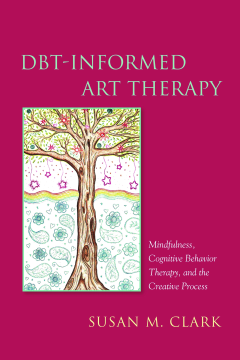
Additional Information
Book Details
Abstract
Understand DBT-informed art therapy, and how to apply it to your practice. Dialectical Behavior Therapy (DBT) treats problems with emotion regulation, and is especially effective in treating chronic self-harming and suicidal behaviors associated with Borderline Personality Disorder. Combining the structure and skill development of DBT with the creativity and non-verbal communication of art therapy can be a significant advantage in treating patients who are resistant to talking therapy.
This book gives a comprehensive overview of the growing literature and research on DBT-informed art therapy, drawing upon the work of pioneers in the field to explain different types of DBT-informed art therapy and the 'Three Ms' at its core: Mindfulness, Metaphor and Mastery. It also includes creative visual exercises and activities for developing the skills of core mindfulness, interpersonal effectiveness, emotion regulation, distress tolerance, and non-judgemental acceptance among clients.
Susan Clark has been an art therapist and counsellor for over 18 years. She possesses extensive experience in leading standard didactic DBT and DBT-informed art therapy skills training groups. Susan is based at The Emily Program in Cleveland, Ohio.
This book provides everything (from theory to practice), that an art therapist needs in order to teach DBT skills. The art therapy activities described in this book offer an alternative and creative way to reach our clients with DBT. On top of that, Clark is a great writer! A pleasure to read.
Lucene Wisniewski, PhD, FAED, Case Western Reserve University and The Emily Program
Susan Clark's fine book is a comprehensive plea for expanding known treatment strategies for formidable disorders of emotion regulation by including treatments that help patients express what words cannot say. She provides an astounding array of creative art activities that, when combined with more traditional talk therapy, bring the power of art, metaphor, paradox, and each client's unique creative sensibility into the therapeutic process.
Dr. Betty Edwards, Professor Emeritus in Art, California State University, Long Beach and author of ‘Drawing on the Right Side of the Brain’
Table of Contents
| Section Title | Page | Action | Price |
|---|---|---|---|
| DBT-Informed Art Therapy: Mindfulness, Cognitive Behavior Therapy, and the Creative Process by Susan M. Clark | 3 | ||
| Introduction | 9 | ||
| Part 1 - The Background | 17 | ||
| Chapter 1 - Standard DBT and Its Adaptations | 18 | ||
| Chapter 2 - Art Therapy | 54 | ||
| Chapter 3 - Mindfulness Practice and Mindfulness as the Core Skill in DBT | 78 | ||
| Chapter 4 - Mindfulness and the Creative Arts Therapies | 97 | ||
| Part 2 - DBT-Informed Art Therapy | 105 | ||
| Chapter 5 - “DBT in Action” | 106 | ||
| Chapter 6 - Stage 1 DBT-Informed Art Therapy | 127 | ||
| Chapter 7 - Mindfulness, Metaphor, and Mastery | 136 | ||
| Chapter 8 - Characteristics and Practices of the DBT-Informed Art Therapist | 149 | ||
| Part 3 - The Activities | 169 | ||
| Chapter 9 - Core Mindfulness Skills | 170 | ||
| Chapter 10 - Interpersonal Effectiveness Skills | 191 | ||
| Chapter 11 - Emotion Regulation Skills | 204 | ||
| Chapter 12 - Distress Tolerance Skills | 232 | ||
| Chapter 13 - Supplemental Skills | 266 | ||
| Part 4 - Stage 2 DBT-Informed Art Therapy and Beyond | 287 | ||
| Chapter 14 - Using Art Therapy Within DBT Stages 2, 3, and 4 | 288 | ||
| Chapter 15 - Developing an Evidence Base for DBT-Informed Art Therapy | 293 | ||
| References | 297 | ||
| Subject Index | 316 | ||
| Author Index | 322 |
